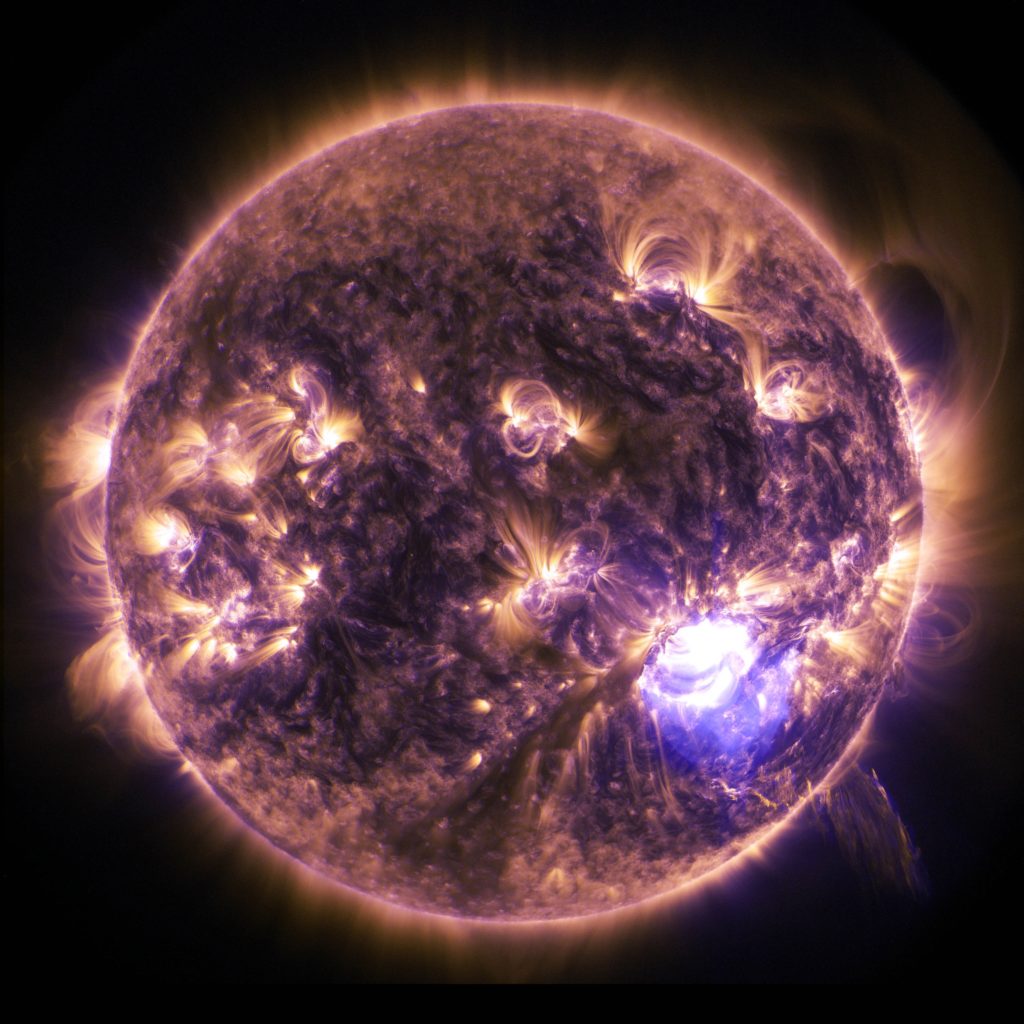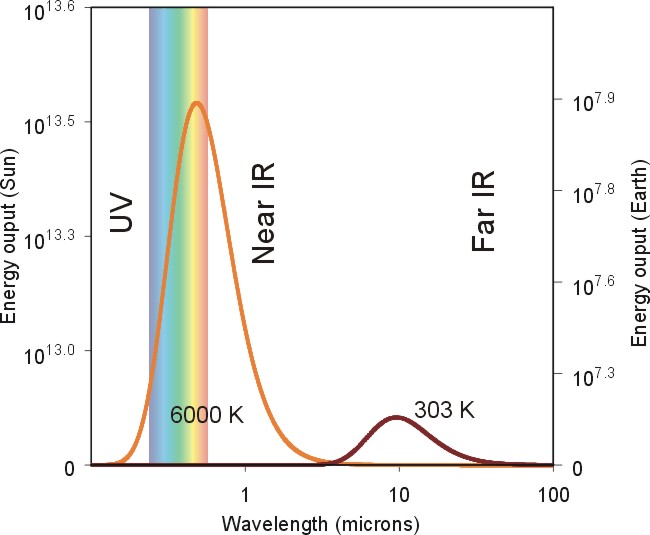Ένας εξωγήινος αστροφυσικός μελετάει το μητρικό μας άστρο και αποφασίζει να στείλει πίσω στη Γη τα αποτελέσματά του για σύγκριση. Οι Γήινοι παρατηρητές εκπλήσσονται με το συμπέρασμά του ότι πρόκειται για ένα πράσινο στην ουσία του άστρο, καθώς όταν κοιτάζουν τον Ήλιο (μην κοιτάζετε τον Ήλιο με γυμνό μάτι!), έχει λευκό-κίτρινο χρώμα.

Τι πραγματικά συμβαίνει; Τι παρεμβάλλεται ανάμεσα στον εξωγήινο και τον γήινο παρατηρητή; Η απάντηση σίγουρα δεν είναι ότι ο εξωγήινος αστροφυσικός έχει αχρωματοψία, αλλά ας πάρουμε τα πράγματα από την αρχή.
Η ορατή επιφάνεια του Ήλιου έχει θερμοκρασία 5772 K (5499 ˚C). Εν γένει, οποιοδήποτε σώμα (σε μη μηδενική θερμοκρασία κατά Kelvin) εκπέμπει θερμική ακτινοβολία, σύμφωνα με τον νόμο του Planck. Μάλιστα, αν ζωγραφίζαμε την ένταση αυτής της ακτινοβολίας συναρτήσει του μήκους κύματός της, θα έμοιαζε με μια ασύμμετρη καμπάνα. Η κορυφή της καμπάνας συμβολίζει το μήκος κύματος στο οποίο εκπέμπεται η περισσότερη ακτινοβολία. Αυτή την κορυφή την προσεγγίζουμε εύκολα με έναν άλλο νόμο, γνωστό ως νόμος μετατόπισης του Wien (και ο νόμος του Planck δίνει εν τέλει το ίδιο αποτέλεσμα, όμως ο νόμος του Wien είναι πιο εύχρηστος):
𝜆𝑚𝑎𝑥 · 𝑇 = 0.29𝑐𝑚 · Κ
Συγκεκριμένα, για ένα σώμα με θερμοκρασία επιφανείας σαν του Ήλιου, η καμπύλη που σχηματίζεται προσεγγίζεται από την κάτωθι:

Πράγματι, βάζοντας στην εξίσωση του Wien την επιφανειακή θερμοκρασία του Ήλιου, το 𝜆𝑚𝑎𝑥 που προκύπτει είναι 502 nm. Εδώ χρειάζεται να αναφέρουμε ότι το ορατό κομμάτι του ηλεκτρομαγνητικού φάσματος κυμαίνεται από τα 380 nm (μωβ χρώμα) έως τα 750 nm (κόκκινο χρώμα). Το 502 nm αντιστοιχεί στο πράσινο χρώμα. Ο Ήλιος, λοιπόν, θα έπρεπε να φαίνεται πράσινος!
Πριν αρχίσει να διαμαρτύρεται, όμως, ο γήινος παρατηρητής και αναγνώστης, οφείλω να τονίσω ότι τα πράγματα εν προκειμένω είναι πιο περίπλοκα. Επειδή εντοπίζουμε το μέγιστο της ηλιακής ακτινοβολίας στα 502 nm, δεν σημαίνει ότι δεν βλέπουμε να λάμπει και σε διπλανά μήκη κύματος (ορατό φάσμα). Η κορυφή της καμπάνας του φάσματος είναι αρκετά πλατιά ώστε να καλύπτει όλα τα ορατά μήκη κύματος σε τέτοιο βαθμό, ώστε το ανθρώπινο μάτι να μην διακρίνει τη διαφορά ανάμεσα στην κορυφή και τα γειτονικά μήκη κύματος. Ως εκ τούτου, ο Ήλιος μας φαίνεται άσπρος!
Λάθος και πάλι! Ο Ήλιος θα φαινόταν άσπρος αν ήμασταν στο διάστημα. Υπάρχει ακόμα ένας καθοριστικός παράγοντας που δεν έχουμε λάβει υπόψη. Η Γη έχει μια ατμόσφαιρα που παρεμβάλλεται ανάμεσα σε εμάς και τον Ήλιο και η οποία ‘‘φιλτράρει’’ τις ακτινοβολίες που εισέρχονται σε αυτή. Εκεί, λοιπόν, η ηλιακή ακτινοβολία σκεδάζεται (σκέδαση ονομάζουμε σε αυτή την περίπτωση την αλλαγή κατεύθυνσης των ηλεκτρομαγνητικών κυμάτων που προσπίπτουν στα σωματίδια που αιωρούνται στην ατμόσφαιρα) ανάλογα με το μήκος κύματός της. Η διάκριση αυτή στα μήκη κύματος γίνεται, διότι ένα μικρότερο μήκος κύματος είναι συγκρίσιμο σε μέγεθος με τα εμπόδια/σωμάτια που θα συναντήσει στην ατμόσφαιρα και έτσι μπορεί να αλληλοεπιδρά μαζί τους και να σκεδάζεται, σε αντίθεση με ένα μεγαλύτερο μήκος κύματος.

Έτσι, τα μωβ-μπλε μήκη κύματος αλλάζουν ευκολότερα κατευθύνσεις στον αέρα, με αποτέλεσμα να μην βλέπουμε αυτά τα χρώματα να προέρχονται από τον Ήλιο, αλλά από τον ουρανό. Επιπλέον, το πρώην λευκό χρώμα του Ήλιου κυριαρχείται πια από τα μεγάλα μήκη κύματος και φαίνεται κίτρινος. Τέλος, καθοριστικής σημασίας είναι και η θέση του Ήλιου στον ουρανό. Όταν ο Ήλιος είναι ψηλά στον ουρανό (μεσημέρι), η ακτινοβολία του πρέπει να διανύσει σχετικά μικρή διαδρομή μέχρι την επιφάνεια της Γης και έτσι προλαβαίνουν να σκεδαστούν μόνο τα μωβ-μπλε μήκη κύματος. Αντίθετα, όταν ο Ήλιος δύει ή ανατέλλει, η ακτινοβολία έχει να διανύσει μεγαλύτερη διαδρομή και έτσι σκεδάζονται και τα πράσινα ή και κίτρινα μήκη κύματος, με αποτέλεσμα να παίρνει πορτοκαλί και κόκκινα χρώματα. Το μητρικό μας άστρο, λοιπόν, μπορεί να μας φαίνεται κίτρινο, πορτοκαλί ή κόκκινο, αλλά ποτέ πράσινο.
Υπάρχουν άραγε άλλοι αστέρες που μοιάζουν πράσινοι;
Πώς η βιολογία μας επηρεάζεται από τη διαστημική μας γειτονιά και το ‘‘χρώμα’’ του άστρου της;
Ποιες άλλες επιδράσεις έχει μια ατμόσφαιρα σε έναν πλανήτη;
Αυτές είναι ερωτήσεις που περιμένουν απαντήσεις…
